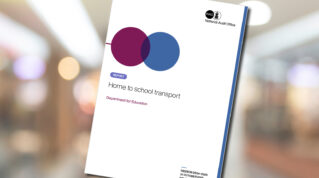According to the latest government figures, just under 1.5 million students in England have special educational needs and disabilites (SEND). These rising statistics highlight the importance of inclusivity for every student in further education. Our experience working across mainstream and specialist colleges has shown the essential role of design in making colleges more accessible – but expensive adaptations often aren’t feasible. Is it possible to create an inclusive college within these constraints?
This year, the government revealed its green paper for educational reform for young people with special educational needs and disabilities (SEND). The paper acknowledges that too often their outcomes fall behind their peers, and sets out proposals to identify students’ needs more efficiently and meet them more consistently.
While this paper is needed to reset the SEND system, it can only be seen as a preliminary framework. They are ambitious proposals, but they’re only the first step in providing a robust and stable education system for young people with SEND – something that may take years, if not decades, to realise.
Despite the obvious challenges of meeting these needs, introducing well-considered changes can have an almost immediate effect on the way young people with SEND cope within their learning environment. These students should have access to resources that can help them develop life skills, ranging from finances to cooking and self-care, in addition to support from staff with counselling and therapy. These services can provide a setting where young people with SEND can be themselves, learning in an environment that suits their needs while allowing them to be with their peers and friends.
While providing support for SEND students is important, a well-designed college should welcome all students – with many affordable changes you can make which will benefit everyone.
Well-considered changes can have an almost immediate effect
To help students navigate a building independently, designing within a single storey is desirable but not always practical. Clear circulation routes and one-way systems can help those struggling in crowded spaces. Timetabling can help with this, by staggering students’ movements throughout the day. Simple landmarks that help students to orient themselves can play an important role in aiding independent navigation, as can simple, clear signage. Vinyl graphics can be a cost-effective way to achieve this.
Many young people with Autism Spectrum Disorder (ASD) have difficulty processing sensory information, as their senses can be intensified or dampened. This can be addressed with a biophilic design approach. Research shows that people are often calmed by hints of nature, so natural colours and materials alongside indoor plants and greenery can help support struggling students.
Noise can also pose a challenge for people with ASD. Deadening reverberations can be vital. When retrofitting an older college, replacing ceiling tiles with class A acoustic tiles provides excellent value for money, as does using acoustic wall boards.
When designing an SEND school or college, we always seek to integrate natural environments into everyday learning by blurring the boundaries of inside and outside and providing inspirational external learning spaces. Spaces within existing facilities can also be adapted in order to create external classrooms, breakout areas and sensory gardens for everyday learning and activities.
Although outdoor classrooms are becoming more common in schools, and for younger children, they also carry huge benefits for young people and adults in the context of further and adult education colleges. Outdoor spaces relieve stress and anxiety, can help develop social skills and motivate learning. Green spaces help to facilitate informal discussion, providing a social space where students can safely test boundaries and develop emotional skills, while also providing quiet social areas for individuals and small groups.
Internally, places of refuge are also important, as there will be times when students with ASD will want to be alone. It is beneficial to have ‘calm’ rooms adjacent to classrooms and incorporate quiet seating areas off the corridors for reading and respite.
While the government’s green paper is a great framework for these aspirations, we must acknowledge that these are long-term objectives – and they demand long-term thinking. It is up to everyone working with the further education system to act now, creating spaces that have a positive impact on the young people who learn in them.















These sorts of elegant design decisions would certainly benefit learners without SEND as well. Designing open spaces, nature-incorporated buildings would be conducive for a better learning environment for all.
By considering these key areas and creating humane spaces all students benefit, all within a limited budget, when designed into new build or retrofit projects from the outset.
I can’t agree more. These sort of design ideas have benefits for all students, and the huge benefit of being inclusive of SEND students as well. I was lucky enough to attend university (not in the UK) that was designed to be inclusive. Even though I don’t fall under this group, I certainly benefited.